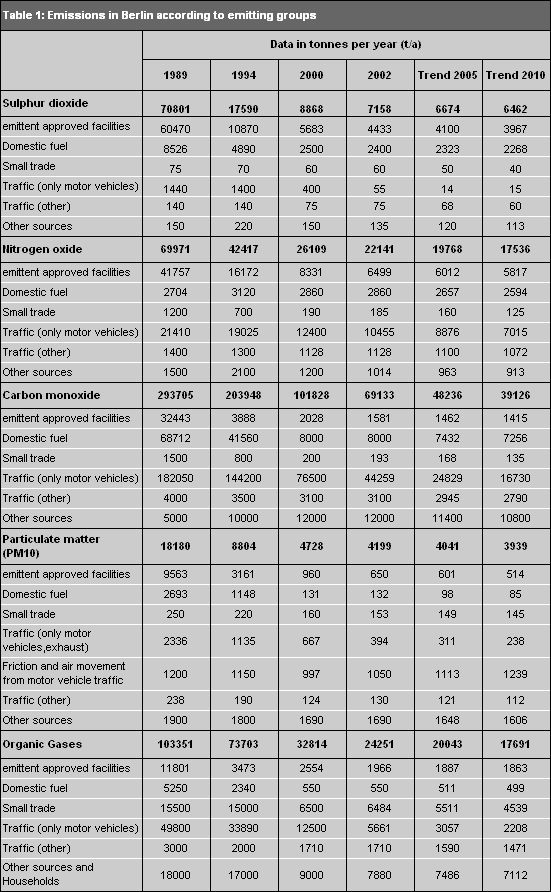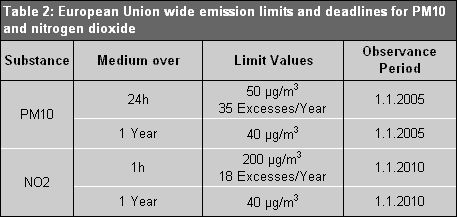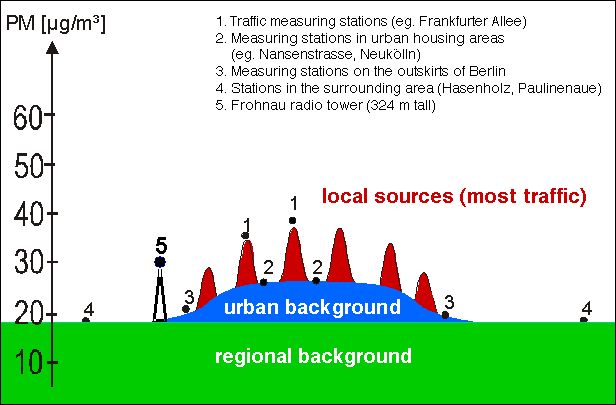In addition, fine particulate emissions from motor vehicle exhaust between 1989 and 2002 have decreased by more than 80 %. This rings true with the readings of measured diesel soot in street ravines – the main component of motor vehicle exhaust emissions: the measured soot concentration on the Frankfurter Allee, in the Berlin district of Friedrichshain, at monitoring station 174 of the Berlin air quality observation network BLUME has fallen by almost 40 % within the last 6 years. However, since fine particulates from friction and air movement caused by street traffic have barely decreased during this time, after other sources, street traffic is the main source of particulate matter in Berlin. Street traffic causes 34 % of the fine particulate emissions in Berlin, while other sources cause 40 %.
By the beginning of the 1990s, street traffic replaced industrial plants as the main source of nitrogen oxides in Berlin. As of 2002 street traffic produces 47 % of the nitrogen oxides in Berlin, whereas industrial plants account for 29 % of the total emissions.
Noticeably high in comparison are the pressures from motor vehicle traffic in the inner city center, where over one million people live in an area of 100 square kilometres. Especially here, if current trends for use of and competition for space continue, motor vehicle traffic will increase. If current conditions continue, especially freight transport will encounter increased bottlenecks in the streets.
In order to influence these partially incompatible but health-relevant developments for the city, Berlin has developed two planning strategies that compliment each other:
With the City Development Traffic Plan, the Berlin Senate (with a resolution from July 8, 2003) has presented an action plan which combines the possible and necessary steps to further develop the Berlin traffic system for the coming years with a long term strategic orientation. The essence of the action plan forms a catalogue of measures that were previously analyzed in detail and balanced according to their effectiveness, acceptance and financability. The investigations of the Clean Air Preservation Plan Berlin are based on this long term action plan in regard to the future development of traffic in Berlin and the surrounding area.
“Health and Safety”, one of the central strategies of the City Traffic Development Plan, already considers a number of important strategies to limit the increase of motor vehicle traffic resulting in the reduction of air and noise pollution in the main traffic network.
The implementation of the measures of the City Traffic Development Plan is expected to be completed by 2015.
In August 2005, the Berlin Senate adopted the EU mandated, standardized Clean Air Preservation Plan.
Pursuant to the European-wide standards, the Clean Air Preservation Plan data must disclose details:
- of pollution measurements;
- of the causes of high pollution levels;
- of the frequency and level of measurements that exceed the limits;
- of pollution emissions and the breakdown of causative factors (e.g. industry, commercial activity, home heating, traffic);
- of the measures and a timetable for implementation; and
- forecast, with an achievable goal.
The Clean Air Preservation Plan at hand discloses information about the legal framework, information about the prevailing situation, and describes the causes of air pollution. The measures take into account future atmospheric changes until 2010. The focal point is the presentation of a broad range of potential measures and their evaluation. Based on the effectiveness of these measures a strategy for the Berlin Clean Air Preservation Plan will be developed. The Clean Air Preservation Plan documents that Berlin, as do many other large German and European cities, is challenged to meet the new EU limits.
The important results came from the “made in Berlin” measures which reduced fine particulates from the urban background and other sources by about half. Urban background pollution is mostly caused by street traffic (16% of the total pollution of PM10). The rest (11%) is made up of approximate equal parts from Berlin residential heating, industry / power plants, construction, and other sources within the city.
The results of the measurements from last year and those carried out with the year 2002 calculation model lead, among other things, to the following conclusions:
- The multi-year trend of fine particulate and nitrogen dioxide pollution barely declines. The high PM10 results in 2002 and 2003, as well as the decline in 2004 are predominately weather related.
- At all measuring stations located close to traffic, the 24 hour limits for fine particulates and the annual limits for nitrogen oxide were exceeded. The calculations for 2002 widely show excesses in all main street traffic networks, especially in the city center.
Effects
Nitrogen oxides are acidifiers. They are harmful to human health, cause damage to plants, buildings, and monuments, and significantly contribute to the excessive formation of ground level ozone and various noxious oxidants during summer heat waves.
Nitrogen oxide, and especially nitrogen dioxide lead to irritation of the mucus membranes of the air passages in people and animals and can increase the risk of infection (see Kühling 1986). As well, cell mutations have been observed (BMUNR 1987). Various epidemiological studies have shown a correlation between the deterioration of the lungs’ respiratory tract symptoms, and increased nitrogen dioxide (see Nowak et al. 1994).
Diesel soot is a major component of fine particulate matter (PM10) in motor vehicle exhaust. It is a carrier for polycyclic aromatic hydrocarbons (PAK), a cancer risk, and, on their own, are also possible causes of lung and bladder cancer (see Kalker 1993). Moreover, ultra fine particles such as diesel soot which are smaller than 0,1 µm, are suspected to increase the risk of cardiovascular disease.
Legal Regulations and Limits
Air pollution from motor vehicle traffic could only be evaluated by emission control authorities starting in 1985, after the European community, in the “Guideline Advice of 7 March, 1985, About Air Quality Standards for Nitrogen Dioxide” (Guideline 85/203/EWG), specified limits and goals for this pollutant. In addition, it prescribed measurements of concentrations of nitrogen dioxide in street ravines and at focal traffic points.
In 1996, due to a multiplicity of new findings regarding this, as well as other air pollutants, “Guideline 96/62/EG About the Evaluation and Control of Air Quality” (the so-called “Framework Guideline”) was written and brought into force.
In this guideline the Commission is called upon to submit, within a specified time period, so-called “Sub Guidelines” specifying limits and details for measurement and evaluation of a given list of components.
In the meantime, three Sub Guidelines have come into force:
- on July 19, 1999, Guideline 99/30/EG, with a limit for sulphur dioxide, fine particulate matter (PM10), nitrogen dioxide and lead;
- on December 13, 2000,Guideline 2000/69/EG, with a limit for benzene and carbon monoxide;
- on February 9, 2002, Guideline 2002/3/EG, for comparing ozone at ground level to the data and elevation of measurements exceeding the limits; and
- on December 15, 2004, Guideline 2004/107/EC, with limits for arsenic, cadmium, mercury, nickel and polycyclic aromatic hydrocarbons.
Two years were allocated to enact the first two Sub Guidelines into law. The first Sub Guideline was enacted in September 2002 in the Seventh Amendment of the State Emissions Protection Act (BImSchG), well beyond the allotted two years. The new Ozone Guideline was, in the meanwhile, enacted into German law in the new 33rd Ordinance of the BImSchG.
The essence of the air quality Guidelines is the emission limits , which “must be achieved within a certain time frame and are not to be exceeded thereafter”. The pollution concentrations, and the time in which the limits must be met, are stipulated in the Sub Guidelines, i.e. in the 22nd Federal E Protection Law.
Table 2 shows the stipulated limits for the two air pollutants which are the largest potential problem for Berlin: PM10 and nitrogen dioxide.



